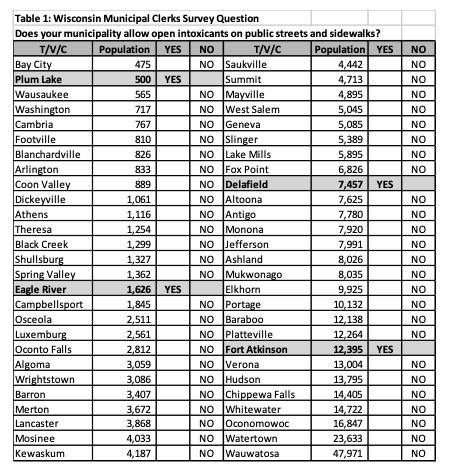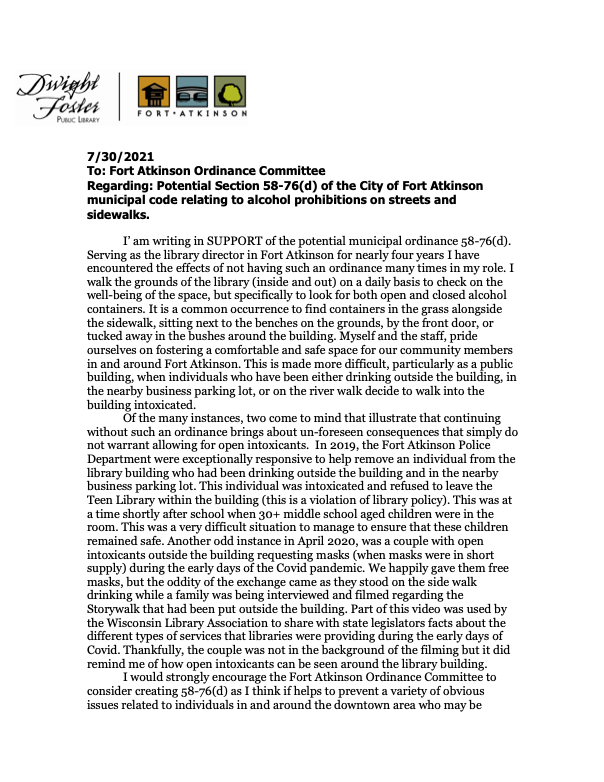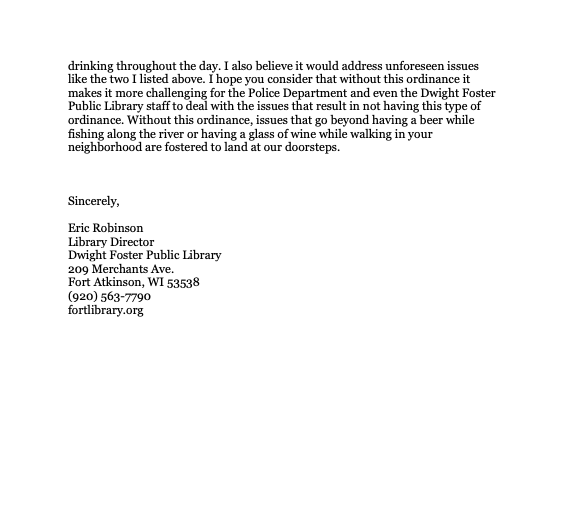By Kim McDarison
The Fort Atkinson City Council Tuesday approved an ordinance prohibiting open containers of alcohol on streets, sidewalks and right-of-ways.
The measure passed by a vote of 3-2, with Councilmen Megan Hartwick and Bruce Johnson voting against it.
Previous discussion
Introduced in June — along with three other alcohol- and public-nuisance-related ordinances which were earlier approved — the alcohol prohibition on streets and sidewalks ordinance was tabled in July after council agreed to give city staff time to more clearly understand any potential ramifications of the proposal.
In July, during discussion, Hartwick, Johnson and Councilman Mason Becker expressed concerns with the ordinance, citing public feedback in opposition to the measure, with Becker further noting concerns stemming from what he said was a “sense of personal freedom.”
Johnson expressed concern about residents who might be cited for sitting near the river with a fishing pole and a beer.
Hartwick said members of the public with whom she had spoken saw the measure as an “overregulation.”
Council asked city staff to explore other remedies to address Fort Atkinson Police Chief Adrian Bump’s concerns regarding enforcement issues as they related to nuisance behavior, especially in the city’s downtown and Riverwalk areas.
Tuesday’s discussion
During Tuesday’s meeting, City Manager Rebecca Houseman LeMire shared with council the results from an inquiry made by City Clerk Michelle Ebbert, which found that of 54 surrounding municipalities responding, 92% did not allow possession of open alcohol in public spaces within their communities. Besides, Fort Atkinson, Ebbert found, three communities — the town of Plum Lake, and the cities of Eagle River and Delafield — allowed open intoxicants in public areas.
LeMire noted that Bump had approached her in March with a request that the city review several ordinances relating to alcohol possession and consumption. His experiences, along with those of his officers, LeMire said, “pointed to the need for additional tools to reduce the nuisance and sometimes dangerous behaviors associated with overconsumption of alcohol.”
According to LeMire, Bump cited such behaviors as disorderly conduct, public intoxication, loud noise, public urination, littering, property damage and fighting.
After the proposed alcohol prohibition on streets and sidewalks ordinance was tabled, LeMire said, it was returned to the city’s Ordinance Committee where it was reviewed on Aug. 3.
The committee recommended, LeMire stated, that the “matter go back to the council on Aug. 17 for definitive action.”
Bump, addressing council, said he wanted to reiterate some earlier talking points.
Bump said he brought the ordinance forward for consideration with the encouragement of the city’s patrol officers.
“Over the last four years, multiple officers came to me and mentioned the need for an ordinance of this type. It wasn’t just a one-time comment that motivated me to take action. This is an accumulation over four years where I finally realized that I have this many officers coming to me and saying this is a need,” Bump said.
“(Officers) want this, and can use this in their daily work as an additional tool to take action and to use at their discretion when dealing with issues … related to public drinking and public intoxication” Bump said.
He cited infractions listed by the city manager, adding: “This is an ordinance to address the root cause of multiple issues, identifying alcohol and drinking as a “constant factor in all of those events.”
Bump said he addressed the Ordinance Committee in August and shared three recent calls for service, which, he said, painted a clear picture of how having an ordinance prohibiting open intoxicants in public places such as streets, sidewalks and right-of-ways was important. He further cited a letter submitted to council written by the city’s library director, Eric Robinson, enumerating incidents with intoxicated individuals both inside and outside of the library.
Hartwick expressed frustration with the process, noting: “It seems a little odd to me to have something come back that we had had the discussion as a council to table in the hopes that it would get reworked or maybe be reframed a little bit differently.”
When the ordinance reappeared on the council’s agenda, she said, “I actually made a point to reach out directly to a few of our local officers. I did get some communication back from three of them — which certainly is not a majority or a reflection of the force by any means — but I guess I was kind of anticipating all three of them to say, ‘yes, we need you to pass this, we need this to happen,’ and none of the three of them said that.”
Hartwick said the officers with whom she spoke discussed with her the possibility of using a curfew as a solution.
“Maybe this is something that should be enacted citywide after a certain time at night because the majority of our issues are coming up at night,” she said, adding that the three officers with whom she spoke agreed that the ordinance as proposed would likely not serve to deter nuisance behaviors stemming from alcohol use.
Said Hartwick: “They said, ‘we don’t feel that this is going to deter these chronic situations that we have with certain individuals in town because a local ordinance doesn’t necessarily allow us to inflict a harsher penalty or a harsher punishment.’”
Bump said using a curfew as a solution had not until Tuesday been presented to him for consideration.
“I think, first of all, you need to decide as a city: are we OK with the behaviors and the actions, and are we OK with the public drinking? And if we’re not OK, then we pass the ordinance as is. If we are not OK with it, but we still want to meet in the middle ground and ensure that we can take some sort of enforcement action, then we need to look at an option that may be some type of restriction. I think there needs to be a decision from the city council which direction we want to go,” Bump said.
Addressing Hartwick’s comments relating to conversations she had with officers, Bump said: “The officers that you reached out to, the reason that you probably didn’t get a huge response, is because it’s not very common for a city council person to reach out to a police officer, and the police officer or city employee might be hesitant to respond to that question for fear of making their boss look bad.
“One of them came to me today and said, ‘hey, I got this message from city council. What do you want me to do?’ and I said, ‘I want you to do what you think is right. Answer her question based on your experience and how you truly feel.’”
Hartwick said she reached out to three and spoke with three, adding that she reached out to gain perspective as part of a process when making a decision about another person’s job.
Johnson said that while he did not reach out to officers, he did speak with “a couple dozen citizens.”
“They were astonished that we were going to do this. It wasn’t popular,” he said.
Johnson said that on several occasions he asked Bump about different scenarios and how they might be handled.
Citing examples of concerning scenarios, Johnson asked: If an individual was going fishing near the river or going to a Packer game party with a beer in his hand, would officers write citations?
Bump said officers would use discretion with this ordinance, as they do with every ordinance.
“We want to gain compliance and we want to make positive impacts. We can do that through education, through warnings and through citation,” he said, adding: “I don’t tell my officers that they have to do one thing or another; they have to evaluate each situation based on the facts they have before them and make a decision that is appropriate. We entrust them, and we coach and mentor them, to police our community in this type of manner.”
Johnson said he has lived in Fort Atkinson for 63 years.
“This is the first time I’m aware that we have a public drinking problem on the sidewalks. I’ve never heard of that before. And I don’t think that exists that way. At the Ordinance Committee, I saw the whole committee kind of sway down a direction that I don’t agree with when you gave three examples from the prior weekend. Can you repeat those for us?” Johnson asked.
Bump read three calls for service received by his department just over two weeks ago.
In the first incident, he said, a female in her 20s or 30s was found unresponsive on the bathroom floor in Ralph Park. The individual making the complaint advised officers that the female appeared to be disoriented. She got up and tried to walk away. A boyfriend carried her purse. Alcohol could be smelled.
In a second incident, Bump read, a person making a complaint advised law enforcement that they had rented Jones Park for a kids’ party. The complainant reported that there were three intoxicated males in the men’s bathroom and one was passed out. The complainant informed police that she did not feel comfortable sending children into the bathroom.
In a third incident, Bump said, a complainant advised police that he had witnessed an intoxicated man who was having trouble walking along Whitewater Avenue near Purdy Elementary School. The complainant witnessed the male urinate in public while on Whitewater Avenue.
Said Bump: “We want to reduce the behavior. We don’t want to have to write tickets. We want to have the right laws in place, the right ordinances in place, because the ordinances themselves have a positive impact on the community. And then, as a last resort, officers have to address the people who violate those laws. And that’s what we want to get away from.”
Citing the letter from the library director, Johnson said he could see a need for the ordinance near the library, but, he said, “I think we painted it with too broad a brush; we painted the whole city with something we should have singled out an area of town that we should enforce this kind of ordinance.”
Looking at other solutions, Hartwick said she could see complications with trying to create restrictions within a geographic area, but, she said, she did see viability in using the curfew approach.
She said the officers she spoke with told her most of the issues take place at night.
She suggested trying a curfew approach and then reevaluating the idea in six months.
Said Becker: “Like many people, when this ordinance was first proposed, I had a lot of concerns and reservations, and as I have said before, I don’t think the role of the city council is just to be like a kind of a pass-through check box.”
Becker pointed to Fort Atkinson’s minority position within Wisconsin of being one of only four communities that allows open intoxicants in public places.
While he knew the city was in the minority, he said, “I didn’t realize that we’re in an extreme minority based on the feedback that Clerk Ebbert was able to gather from over 50 different communities. I mean I look at this list and the ordinance simply brings us in line with most of our neighbors … I see on this list Watertown, Whitewater, Oconomowoc, Lake Mills, Jefferson, and as far as I know, people can still enjoy alcohol in many different ways in most communities. I haven’t heard that there’s a big crackdown on people enjoying a beer in Jefferson for example.”
Becker said he believed the calls for service cited by Bump served as good examples, showing a need for the proposed ordinance.
“I personally wish there wasn’t a need. I would like to think that our community can hold their liquor responsibly and enjoy it wherever they want and it would be fine, but unfortunately I think too many bad apples have kind of caused a need for this to come before us.”
If, in the future, council was made aware that the police department was misapplying the ordinance, it could be revisited, Becker said.
“Our police chief has made a very good case here and I think we’ve established a need, and I think it simply is bringing us in line with all of our neighbors. Where as before I was kind of leaning against this ordinance, I think tonight, I’m leaning in favor of it in the spirit of simply giving the police another tool to bring about reasonable compliance,” Becker said.
Council President Chris Scherer asked Bump if any of the people in his examples were given citations.
Bump said in the first scenario, no citations were issued and the couple was “moved along.”
“We had nothing we could really cite them for,” he said.
In the second scenario, one person was cited and another was taken into custody for reasons other than those enumerated with the initial call.
In the third scenario, he said, the individual was cited for urinating in public.
“We now have that ordinance,” Bump said.
Scherer said he believed council needed to consider the city’s “public perception.” He took encouragement, he said, from knowing that the police would have an enforcement tool to help address the types of behaviors Bump cited appropriately.
“We are elected representatives, but we are all leaders, and I think we are torn a little bit because we want to represent our constituents, but we also know we want to lead our community in the right direction,” Scherer said.

A list of 54 communities, as developed by the city, shows the answer given by their city clerks when asked: Does your municipality allow open intoxicants on public streets and sidewalks?


The above letter from the city’s public library director was submitted to council is support of the city ordinance relating to alcohol prohibitions on streets and sidewalks.
This post has already been read 3595 times!
